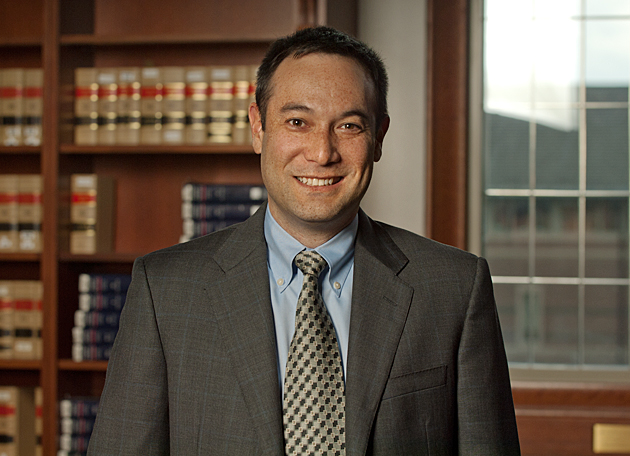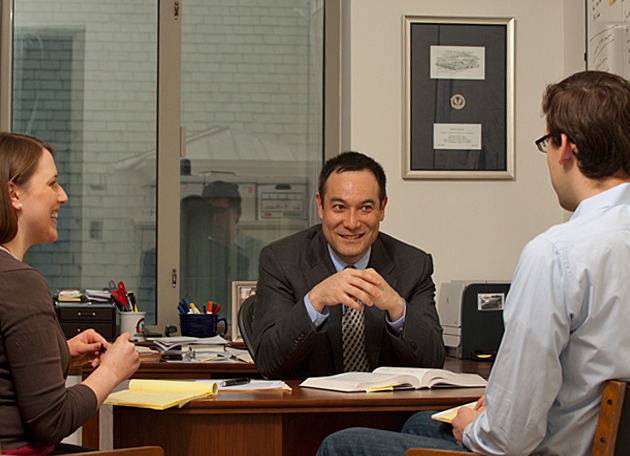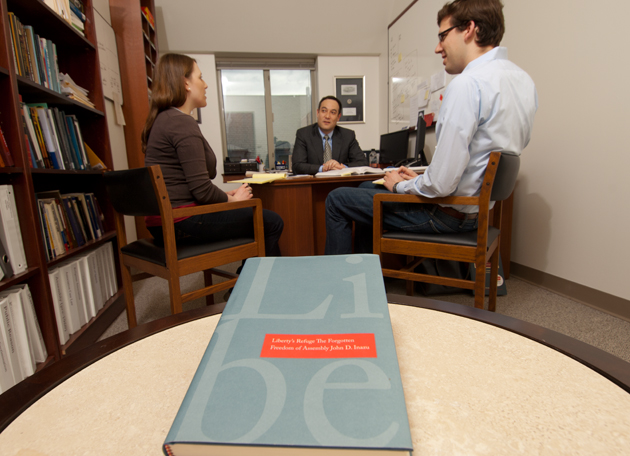
Congress shall make no law respecting an establishment of religion, or prohibiting the free exercise thereof; or abridging the freedom of speech, or of the press; or the right of the people peaceably to assemble, and to petition the Government for a redress of grievances. —United States Constitution, Amendment I
John Inazu, JD, PhD, associate professor of law, didn’t study the freedom of assembly in law school. The U.S. Supreme Court has not addressed the issue in more than three decades. Yet assembly is one of the basic rights set forth in the First Amendment to the Constitution, heralded less than a century ago as one of the “four freedoms” central to the Bill of Rights (before President Roosevelt announced a different “four freedoms” better known today).
Why has this important right disappeared from public discourse? And what has been lost with it? Inazu began pondering these questions while working as a judicial law clerk prior to graduate school.
“I was working on a case involving the First Amendment and was looking at the text. I thought, I’ve practiced law for four years and had three years of law school, and I’ve heard nothing about the assembly clause.”
“When I published my first article on assembly, there were only three of us who had written on it in 20 years, even though it’s one of the five textual provisions in the First Amendment, and the First Amendment attracts so much attention from scholars.”
—John Inazu, JD, PhD
Intrigued, he began to research the issue in earnest, discovering an “extreme hole” in the scholarship.
“Almost no one had written about the right of assembly. The Supreme Court hadn’t touched it in 30 years. When I published my first article on assembly in 2009, there were only three of us who had written on it in 20 years, even though it’s one of the five textual provisions in the First Amendment, and the First Amendment attracts so much attention from scholars.”
In Liberty’s Refuge: The Forgotten Freedom of Assembly (Yale University Press, 2012), Inazu begins by delving into historical interpretations of the assembly clause, from its early appearance in Colonial American discourse and state constitutions through the Federalist debates on the balance of power and beyond to the pivotal movements of the 19th and 20th centuries — abolition, women’s suffrage, labor and civil rights. That historical context is critical to understanding why assembly remains a vital freedom today.
The beneficiaries of these movements are indebted to the assembly clause. Without it, groups that operated outside the mainstream could never have generated enough momentum to effect change. The right to assemble provided them opportunities to craft their arguments, to exchange ideas and impel to action, despite often overwhelming opposition.
The right of blacks in the antebellum South to assemble, even for the purpose of worship, was curtailed through state and local legislation. Protestors interrupted suffragist meetings and assaulted speakers. More recently, the NAACP fought all the way to the Supreme Court for its right to protect its members from state interference. Along the way, significant questions were addressed, such as distinctions between private and government infringement upon assembly, the degree to which states are bound by the First Amendment, and how the courts weigh First Amendment rights against national security and antidiscrimination law.

Both the political left and right have benefited from the exercise of this right, and both have tried to limit it when their particular interests were at stake. Today, the significance of the right to assemble is exemplified by the tension between the Occupy and the Tea Party movements.
But Inazu points out that assembly need not be overtly political. The assembly clause has been invoked to protect a variety of activities, including picnics and public dancing. Moreover, our understanding of what constitutes political assembly or expression changes over time.
The constitutional “right of association” came into being when the Supreme Court first announced it in its 1958 decision NAACP v. Alabama ex rel. Patterson.
Since then, the court has adopted nuances of association, such as “intimate association” and “expressive association.” Inazu argues that the concept of expressive association, in particular, creates a false dichotomy between a group’s practices and its message.
“There’s a point where, if you’re not careful to tie something as significant as a constitutional right to that which gives it footing and traction, then you run the risk of developing it in an unbounded or unprincipled way.”
—John Inazu, JD, PhD
“There’s a point where, if you’re not careful to tie something as significant as a constitutional right to that which gives it footing and traction, then you run the risk of developing it in an unbounded or unprincipled way,” he says. “The best example of the unprincipled application of association, historically, is the split between the Communist and the NAACP cases in the 10 years after the Supreme Court announced the right of association.”
During the Cold War, the Supreme Court upheld the NAACP’s First Amendment claims, but failed to do so for groups with communist ties.
“The court could have established a principled reason for making that distinction,” Inazu continues, “but its failure to do so suggests an amorphous doctrine that can be channeled in politically expedient ways, which is scary.”
Over the years, courts have affirmed that freedom of association “presupposes a freedom not to associate,” as Justice William J. Brennan Jr. wrote in his majority opinion in Roberts vs. United States Jaycees, a decision forcing the Jaycees to accept women as full voting members. Roberts and subsequent decisions illustrate the court’s uneven treatment of the right of association, particularly when it collides with antidiscrimination law. By treating groups’ attempts to limit their membership as conduct rather than expression, the court has ignored the First Amendment’s assembly clause.
While the Boy Scouts’ right to determine its membership was upheld in a 2000 decision, other groups have not met with the same success. In 2010, Inazu writes, the Supreme Court “merged” speech and association claims in Christian Legal Society v. Martinez when it “relied on a muddied area of free speech doctrine to deny the right of a religious student group to limit its membership to those of its choosing.” Inazu argues that the court failed to recognize that a group that cannot control its membership and leadership cannot control its message. When courts ignore assembly in favor of expressive association or speech, according to Inazu, they don’t offer very rigorous protections, at least when confronted with antidiscrimination norms.
“The concept of assembly dropped out of common discourse for lots of reasons,” Inazu says. “Some are historical and some are sort of happenstance. We have a limited sense of what assembly means today because we just haven’t thought and talked about it for a long time.”

Although, at first glance, there appears to be a strong parallel between the historical broadening of the concept of speech to expression and the move from assembly to association, there is in fact a lack of symmetry between the two developments.
“The word ‘speech’ is a narrow concept in itself, but our freedom of speech is much broader than that. Almost everyone accepts that broadening,” Inazu says. “To the extent that we use speech and expression interchangeably, we tie the word ‘expression’ to speech and to the First Amendment. But we don’t do the same with assembly and association. If anything, most scholars link the right of association to speech, which is both artificially narrow and a misreading of the early case law on association.”
As a result, the word “association” seems broader than assembly but, paradoxically, offers fewer protections to autonomous groups.
“To me the logical consequence of it losing assembly is ultimately that we lose any kind of a meaningful pluralism,” Inazu says. “If we don’t take seriously this consequence, then we end up with state-enforced orthodoxy.”
Challenges remain going forward, as Inazu argues in an article titled “Virtual Assembly,” which is forthcoming in the Cornell Law Review. Assembly in the digital age is radically different than it was even 10 years ago. In virtual space, private groups gather and exist on commercial platforms, and commercial organizations historically have been afforded fewer protections from government interference.
The way to change our trajectory and reclaim the constitutional right of assembly, Inazu believes, is to litigate cases like Martinez from the perspective of the assembly clause as a distinct right, and steer courts away from the concept of expressive association and its deepening link to speech.
“This is a practical hope,” he says. “It’s in the Constitution; the Supreme Court has not said that it’s no longer relevant.”
Terri McClain is a freelance writer based in St. Charles, Mo.
You can learn more about Liberty’s Refuge on Professor Inazu’s website.
Comments and respectful dialogue are encouraged, but content will be moderated. Please, no personal attacks, obscenity or profanity, selling of commercial products, or endorsements of political candidates or positions. We reserve the right to remove any inappropriate comments. We also cannot address individual medical concerns or provide medical advice in this forum.